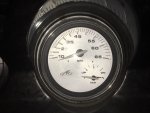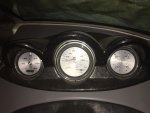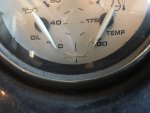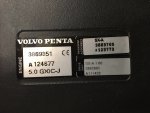I have a 2010 Volvo Penta SX-A 1.60 I/O drive and the trim indicator on the dash panel isn't working anymore. When I turn the ignition on, the needle on the gauge goes from the resting place on the pin to the full up indication. It doesn't matter where the drive actually is, it will always read full up. I have tried removing the sender from the drive and rolling it's shaft back and forth, but it makes no difference.
I have looked it up and the part number for this sensor is 22005045. It is a three wire "non-contact" type sensor. It seems to cost about $230 so I really want to know where the problem is before just buying this part. Removing this part completely from the boat will require cutting the wires as the stupid boat builder provided no access to the inside of the transom area. You basically have to remove the engine to get back there, so cutting and splicing wires seems easier.
My question is- are there diagnostic procedures I can run to be sure the sensor is the problem, or if the gauge is the problem, or the wiring is the problem. Visual inspection of all three as best I can, shows them to be in excellent condition on the outside.
I will also mention another problem I am having with this boat only because I suppose there is a remote chance the two problems might be related as they are both electrical in nature. This boat has always since the day it was new, blown the fuse for the NAV / Anchor lighting while underway. When you test the system on the trailer, it works perfectly and the load on the fuse is well below fuse capacity when metered. Take it out on the water and the fuse blows. I assume there is bad wiring I need to track down somehow that when it gets giggled, it shorts out. I only mention this other problem as I wonder if this shorting may have effected the trim sensor too?
Any help is greatly appreciated! Thanks in advance,
Dave
I have looked it up and the part number for this sensor is 22005045. It is a three wire "non-contact" type sensor. It seems to cost about $230 so I really want to know where the problem is before just buying this part. Removing this part completely from the boat will require cutting the wires as the stupid boat builder provided no access to the inside of the transom area. You basically have to remove the engine to get back there, so cutting and splicing wires seems easier.
My question is- are there diagnostic procedures I can run to be sure the sensor is the problem, or if the gauge is the problem, or the wiring is the problem. Visual inspection of all three as best I can, shows them to be in excellent condition on the outside.
I will also mention another problem I am having with this boat only because I suppose there is a remote chance the two problems might be related as they are both electrical in nature. This boat has always since the day it was new, blown the fuse for the NAV / Anchor lighting while underway. When you test the system on the trailer, it works perfectly and the load on the fuse is well below fuse capacity when metered. Take it out on the water and the fuse blows. I assume there is bad wiring I need to track down somehow that when it gets giggled, it shorts out. I only mention this other problem as I wonder if this shorting may have effected the trim sensor too?
Any help is greatly appreciated! Thanks in advance,
Dave























